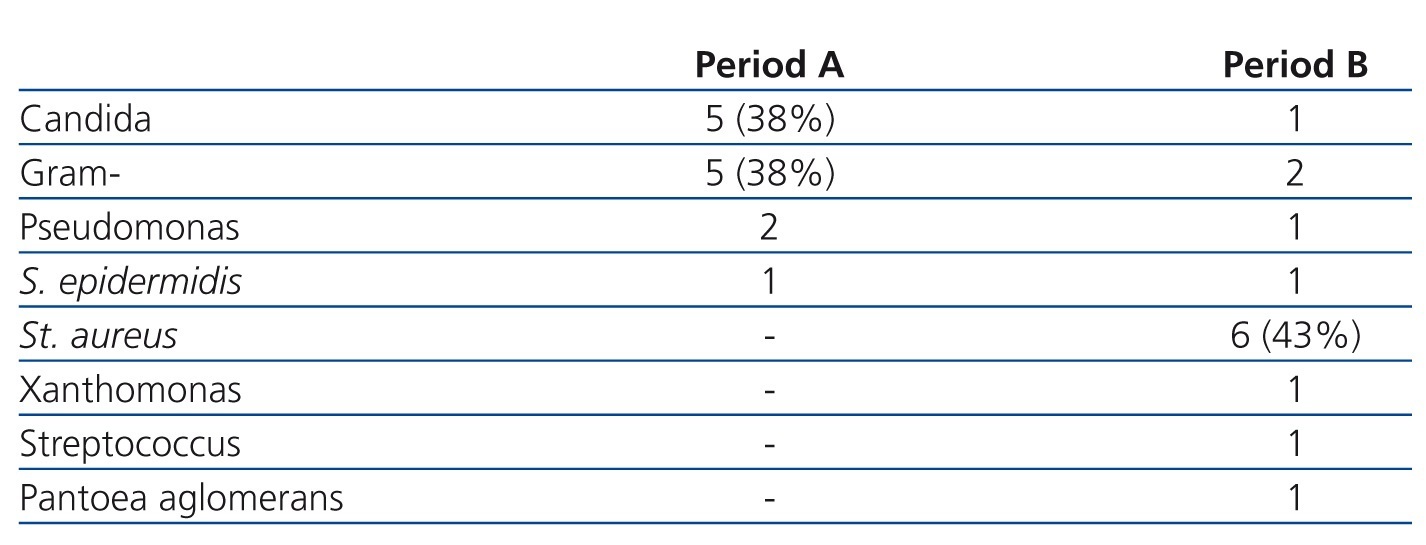To the Editor:
Peritonitis is the primary cause of morbidity, mortality, and technique failure in patients on peritoneal dialysis (PD). More than one-fourth of all patients suffer a case of peritonitis at some point that requires interruption of PD and transferral of the patient to haemodialysis.1
In this context, we performed a retrospective study to evaluate the prevalence and aetiology of cases of peritonitis that have occurred in our department during the last 20 years.
We included all patients who abandoned PD during the study period due to peritonitis. We established two study periods of 10 years each, with the dividing point between them characterised by changes to antibiotic protocols, the use of anti-fungal prophylaxis, and advancements in hook-up technology.
Peritonitis was the third-leading cause of abandoning PD (15%), surpassed only by transplantation (43%) and death (22%).
A total of 13 cases of peritonitis caused interruption of PD during the first time period (A) and 14 in the second period (B). The causative agents of these cases of peritonitis are described in the Table 1. We observed a notable change in the aetiology of the cases of peritonitis between the two study periods; infection by S. aureus predominated in period B, as compared to predominantly fungal and gram-negative bacterial infections in the first period.
Cases of peritonitis caused by gram-negative bacteria and fungi are the primary infectious causes of abandoning PD,2 as we observed in period A.
In our study, the change in antibiotic protocols, with the advent of the use of intra-peritoneal ciprofloxacin, has produced a change in the relative frequencies of the various microorganisms responsible for the most aggressive types of peritonitis, thus significantly decreasing the rate of infection by gram-negative bacteria.
Cases of peritonitis caused by S. aureus are, in general, the most severe types of peritonitis caused by gram-positive bacteria, and these occur most commonly in patients with nasal S. aureus carriage or colonisation of the skin and hands, or in relation to colonisation and infection of the catheter outflow orifice.3
In our experience, we also observed an increase in the virulence of S. aureus that produced peritonitis in the second period, as this bacterium became the primary infectious cause of abandoning PD. We believe that resistance to vancomycin was the primary factor in impeding the resolution of these infections and thus the continuity of PD.
This increase in the resistance to vancomycin will also require reformulating the antibiotic protocol, orientating treatment for the best coverage of gram-positive infections.
Fungal peritonitis constitutes between 1% and 15% of all peritonitis episodes occurring in patients on PD, although its incidence has decreased notably with the use of adequate preventative measures, such as the administration of fluconazole whenever antibiotics are prescribed to the patient for any reason.4 This led to the decrease in the percentage of cases of peritonitis produced by fungi that caused patients to abandon PD from 38% in the first period to 7% in the second period.
The epidemiology of peritoneal infections is heavily influenced by the antibiotic regimens utilised in each hospital department, causing the frequency and resistance of the microorganisms responsible for these infections to vary over time. This requires a critical regimen of periodical changes to antibiotic protocols, changing and adapting them as needed to emerging scenarios of causative microorganisms and their acquired resistances.
Conflicts of interest
The authors state that they have no potential conflicts of interest related to the contents of this article.
Table 1. Aetiology of cases of peritonitis that caused abandonment of peritoneal dialysis







